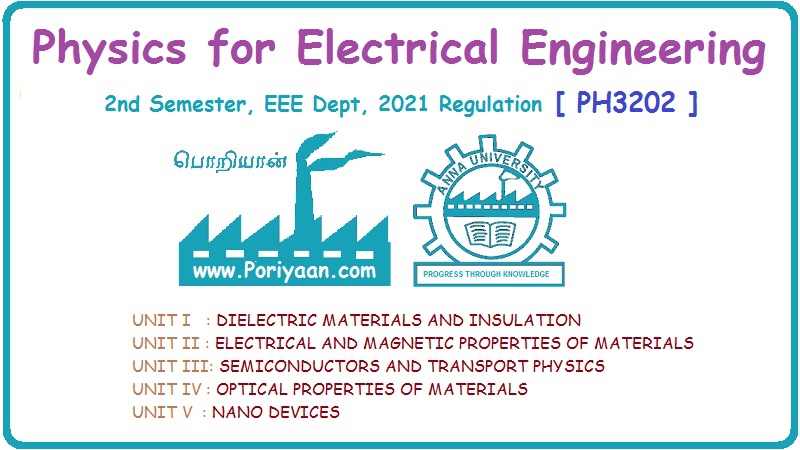Physics for Electrical Engineering: Unit II: a. Electrical Properties of Materials
Classical free electron (cfe) theory of metals
Electrical Properties of Materials
The classical free electron theory of metals was proposed by P. Drude in the year 1900 to explain the electrical conduction in metal. This theory was further extended by H. A. Lorentz in the year 1909.
CLASSICAL
FREE ELECTRON (CFE) THEORY OF METALS
The
classical free electron theory of metals was proposed by P. Drude in the year
1900 to explain the electrical conduction in metal. This theory was further
extended by H. A. Lorentz in the year 1909.
We
know that an atom consists of a central nucleus with positively charged protons
surrounded by the electrons of negative charge.
The
electrons in the inner shells are called core electrons and those in the
outermost shell are called valence electrons (Fig. 2.1).
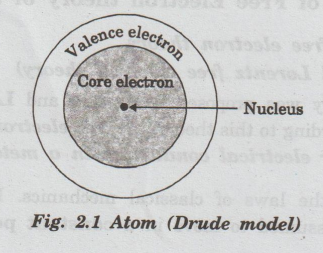
In
a metal, when the valence electrons of each atom detach from the orbit, then
they move freely throughout the metal. These electrons are known as free or conduction electrons.
Postulates of classical free
electron theory
1.
According to this theory, a metal consists of very large number of free
electrons. These electrons move freely throughout the volume of the metal. The
movement of the free electrons is mainly ano responsible for the electrical
conduction in the metal.
2.
Drude assumed that the free electrons in the metal form an electron gas. They
move randomly in all possible directions just like the gas molecules move in a
container.
The
arrangement of atoms in a metal is viewed as an array of atoms (ions)
surrounded by a gas of free electrons. Here, the mutual repulsion between the
electrons is neglected. (Fig. 2.2)
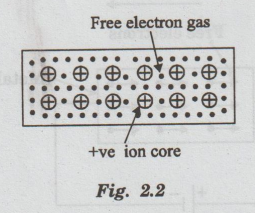
3.
In absence of an electrical field, the free electrons (electron gas) move in
all directions in a random manner.
They
collide with other free electrons and positive. ion core during the motion.
This collision is known as elastic collision (Fig 2.3).
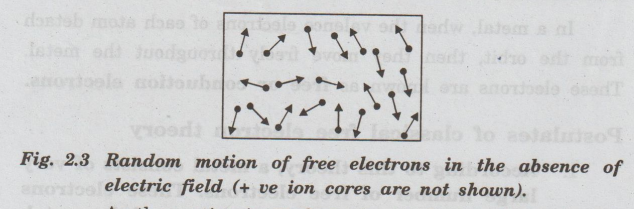
As
the motion is random, the resultant velocity in any particular direction is
zero.
4.
When the electrical field is applied the electrons get some amount of energy.
These electrons begin to move towards the positive potential (in opposite
direction to the applied electrical field).
They
continue to collide with positive ion cores fixed bein the lattice. As a
result, the free electrons acquire a constant average velocity known as drift
velocity ass (Fig. 2.4).
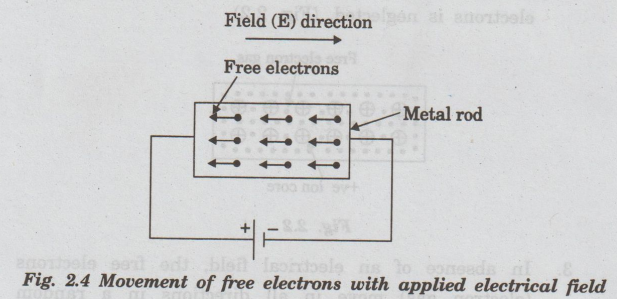
5.
The velocity and the energy distribution of free electrons are governed by
classical Maxwell distribution function.
6.
Since the electrons are assumed to be a perfect gas, they obey the laws of
kinetic theory of gases.
Therefore,
the free electrons are assigned with mean free path, mean collision time and
average velocity.
Drift velocity (vd)
It is defined as the average
velocity acquired by the free electrons of a metal in a particular direction by
the application of an electrical field.
It
is expressed as

where
λ - mean free path
τc - collision time.
Mean free path (λ)
The average distance travelled by a
free electron between any two successive collisions is known as mean free path.
It is represented by λ.
It
is the product of drift velocity of free electrons (vd) and
collision time (τc).
λ
= vd τc
Collision time (τc)
The average time taken by a free
electron between any two successive collisions is known as collision time of
the electron.
It
means that the electron on an average travels for a time τ before its next
collision.
It
is given by
τc = λ / Vd
where
λ - mean free path
Vd
- drift velocity
Relaxation time (τ)
The average time taken by a free
electron to reach its equilibrium state from its disturbed state due to the
application of an external electrical field is called relaxation time.
In
other words, it is the measure of time that the electrons relax when the
electrical field is the electrical field is removed. It is approximately equal
to 10-14 second.
For
isotropic material such as metal collision time (τc) = relaxation
time (τ).
Physics for Electrical Engineering: Unit II: a. Electrical Properties of Materials : Tag: : Electrical Properties of Materials - Classical free electron (cfe) theory of metals
Related Topics
Related Subjects
Physics for Electrical Engineering
PH3202 2nd Semester 2021 Regulation | 2nd Semester EEE Dept 2021 Regulation
